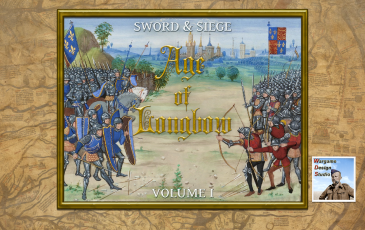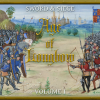002.ALB1_Boot Camp 2 - WDS Age of Longbow Volume I

 0 - 0 - 0
0 - 0 - 0

| Rating: | 0 (0) |
| Games Played: | 0 |
| SM: | 1 |
| Turns: | 18 |
| Type: | Stock |
| First Side: | Side_A (ALB1) |
| Second Side: | Side_B (ALB1) |
Boot Camp 2: Infantry against Cavalry
In this scenario, the outnumbered English force is deployed behind a stream, which provides good protection against cavalry, since cavalry can only cross along a road hexside without getting disrupted. The English Men-at-arms near the crossing point are already deployed in block formation as a precaution, but the archers are unable to use this formation. The Welsh archers on the left flank are not only across the stream but also safely in woods, so are in open order, which allows them to move in woods without getting disrupted and also reduces the effectiveness of any enemy fire. However, it is a weaker melee formation than ordinary line. The English archers in the center and on the right flank are mostly in open ground and so in ordinary line formation. Some early field artillery are deployed in support, but these are not powerful guns and some have limited range.
There are also two units of spearmen - one Welsh and one English - held in reserve just behind the front line, one of which is guarding a supply wagon. These units can use line, block and column formation and, in order that they can redeploy quickly to any danger spot, are currently in column as this is the fastest moving formation. Units in column formation can enter difficult terrain without disrupting and this is the only formation that can benefit from road movement. However, column is a relatively poor combat formation, so should generally be avoided when in proximity to the enemy.
The English also have two smaller units of "dragoon" type cavalry which can fight either mounted or dismounted. One is held in reserve on the road and the other is deployed further south on the map guarding a bridge in case the enemy send troops in this direction to outflank the English position.
The visible French troops facing the English line are cavalry - these are generally the best French troops, but the light cavalry on the left are lower quality irregular horse. Some French infantry - a mixture of crossbowmen and militia spearmen - are believed to be advancing along the road behind the cavalry. French crossbowmen have much slower firing weapons than the English longbows, but if they have pavices - large shields - this will give them good protection from arrows.
French militia spearmen are generally low quality troops and will need to switch from fast moving column formation into block formation in order to melee more effectively. Some militia may have some protection against arrows - whether shields or padded & leather armor - but others are likely to be completely unarmored and so highly vulnerable to arrows. However, these spearmen can be quite dangerous if they manage to keep good order and obtain good melee odds.
If the French cavalry attempt a direct assault across the stream, they will automatically become disrupted and should easily be repulsed, but there is open ground on the English right flank and, should the cavalry get across the stream they will become dangerous once they've recovered good order.
While the English defensive position is quite a good one, it'll be necessary to avoid too passive a defensive stance and be ready to respond to enemy action and any unexpected developments. There are two objectives and a fixed supply wagon in the rear to protect, but victory or defeat will largely depend on inflicting as many casualties as possible on the advancing enemy whilst keeping ones own casualties to a minimum.
Recommended Rules: [Default]
Note: Side A = French Side B = English
Primarily intended for play as the English side against the French A/I but, for a different sort of challenge, could also be played the other way against the English A/I. Can also be played Head-To-Head.
In this scenario, the outnumbered English force is deployed behind a stream, which provides good protection against cavalry, since cavalry can only cross along a road hexside without getting disrupted. The English Men-at-arms near the crossing point are already deployed in block formation as a precaution, but the archers are unable to use this formation. The Welsh archers on the left flank are not only across the stream but also safely in woods, so are in open order, which allows them to move in woods without getting disrupted and also reduces the effectiveness of any enemy fire. However, it is a weaker melee formation than ordinary line. The English archers in the center and on the right flank are mostly in open ground and so in ordinary line formation. Some early field artillery are deployed in support, but these are not powerful guns and some have limited range.
There are also two units of spearmen - one Welsh and one English - held in reserve just behind the front line, one of which is guarding a supply wagon. These units can use line, block and column formation and, in order that they can redeploy quickly to any danger spot, are currently in column as this is the fastest moving formation. Units in column formation can enter difficult terrain without disrupting and this is the only formation that can benefit from road movement. However, column is a relatively poor combat formation, so should generally be avoided when in proximity to the enemy.
The English also have two smaller units of "dragoon" type cavalry which can fight either mounted or dismounted. One is held in reserve on the road and the other is deployed further south on the map guarding a bridge in case the enemy send troops in this direction to outflank the English position.
The visible French troops facing the English line are cavalry - these are generally the best French troops, but the light cavalry on the left are lower quality irregular horse. Some French infantry - a mixture of crossbowmen and militia spearmen - are believed to be advancing along the road behind the cavalry. French crossbowmen have much slower firing weapons than the English longbows, but if they have pavices - large shields - this will give them good protection from arrows.
French militia spearmen are generally low quality troops and will need to switch from fast moving column formation into block formation in order to melee more effectively. Some militia may have some protection against arrows - whether shields or padded & leather armor - but others are likely to be completely unarmored and so highly vulnerable to arrows. However, these spearmen can be quite dangerous if they manage to keep good order and obtain good melee odds.
If the French cavalry attempt a direct assault across the stream, they will automatically become disrupted and should easily be repulsed, but there is open ground on the English right flank and, should the cavalry get across the stream they will become dangerous once they've recovered good order.
While the English defensive position is quite a good one, it'll be necessary to avoid too passive a defensive stance and be ready to respond to enemy action and any unexpected developments. There are two objectives and a fixed supply wagon in the rear to protect, but victory or defeat will largely depend on inflicting as many casualties as possible on the advancing enemy whilst keeping ones own casualties to a minimum.
Recommended Rules: [Default]
Note: Side A = French Side B = English
Primarily intended for play as the English side against the French A/I but, for a different sort of challenge, could also be played the other way against the English A/I. Can also be played Head-To-Head.





















